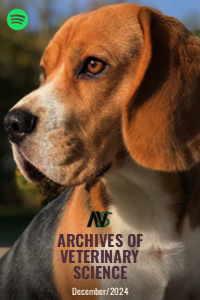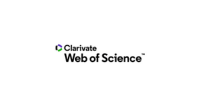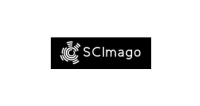Does size matter? Aspects (survival and seasonality) that influence birds with cranioencephalic trauma admitted at a wildlife rehabilitation center in Rio Grande do Sul, Brazil
DOI:
https://doi.org/10.5380/avs.v29i4.95996Palavras-chave:
avian conservation, head trauma, ornithology, survival rate, traumatic brain injury, veterinary medicineResumo
Birds with craniocephalic trauma (CET) show clinical signs such lack of proprioception, hypothermia, altered respiratory rates, fractures, and potential blindness. Treatment focuses on life support, including low-stimulus environments, analgesia, anti-inflammatory drugs, fracture immobilization, and patient stabilization through warmth, oxygenation, hydration, and soft food. Recovery time is uncertain, often resulting in death within days. Factors influencing recovery include injury severity, species size, treatment speed, presence of other diseases, and stress levels. We analyzed the species and their characteristics, occurrences periods, and outcomes of 265 birds of 60 species with CET received at the Wildlife Study Group at the University of Passo Fundo (GEAS-UPF) between 2015-2023. Most cases (72%) succumbed to death on average three days after admission, with small-sized birds having the highest mortality rate (86%). Passeriformes and Strigiformes were the most frequent orders, and the predator guild was the most affected.
Referências
da Rocha Araújo, A.R., Nascimento, M.D.N.C.F., and Junior, V.C.S. 2022. Efetividade da educação ambiental como instrumento de mudança comportamental na Vila do Conde, Barcarena/PA. Brazilian Journal of Animal and Environmental Research, 5(2): 1747-1761.
Basilio, L.G., Moreno, D.J., and Piratelli, A.J. 2020. Main causes of bird-window collisions: a review. Anais da Academia Brasileira de Ciências, 92.
Barros, L.C. 2010. Morte de pássaros por colisão com vidraças. Revista Ciências do Ambiente On-Line, 6(3).
Bencke, G.A., and Bencke, C.S.C. 1999. The potential importance of road deaths as a cause of mortality for large forest owls in southern Brazil. Cotinga, 11: 79-80.
Benítez-López, A., Alkemade, R., and Verweij, P.A. 2010. The impacts of roads and other infrastructure on mammal and bird populations: a meta-analysis. Biological conservation, 143(6): 1307-1316.
Brown, B.B., Santos, S., and Ocampo-Peñuela, N. 2021. Bird-window collisions: Mitigation efficacy and risk factors across two years. PeerJ, 9: e11867.
CENIPA – Centro de Investigação e Prevenção de Acidentes Aeronáuticos. 2020. Anuário de Risco de Fauna 2011-2020. 47 p.
Coles, B.H. Some considerations when nursing birds in veterinary premises. 1984. Journal of Small Animal Practice, 25(5): 275-288.
Fornazari, G.A., Saldanha, A., Lange, R.R., Froes, T., Klem Jr., D., Moore, B.A., and Montiani-Ferreira, F. 2021. Window Collisions by Birds in Brazil: Epidemiologic Factors and Radiographic and Necropsy Assessments. Journal of Avian Medicine and Surgery, 35(3): 313-324.
Graves, R.A., Pearson, S.M., and Turner, M.G. 2019. Effects of bird community dynamics on the seasonal distribution of cultural ecosystem services. Ambio, 48(3): 280-292.
Heyman, E., Gunnarsson, B., and Dovydavicius, L. 2017. Management of urban nature and its impact on bird ecosystem services. p. 465-488. In: Murgui, E., and Hedblom, M. Ecology and conservation of birds in urban environments. Springer. 525 p.
Hu, H., Junqing, T., Yi, W., Hongfeng, Z., Yingchun, L., Lina, S., Yan, L., Wei, Z., Chao, W., Dong, W., and Xiaomin, W. 2020. Evaluating bird collision risk of a high-speed railway for the crested ibis. Transportation research part D: transport and environment, 87: 102533.
Isaksson, C. 2018. Impact of urbanization on birds. Bird species, 235: 257.
Jenkins, J.R. 2016. Critical care of pet birds. Veterinary Clinics: Exotic Animal Practice, 19(2): 501-512.
Jetz, W., Wilcove, D.S., and Dobson, A.P. 2007. Projected impacts of climate and land-use change on the global diversity of birds. PLoS biology: 5(6): e157.
Klem Jr., D. Bird Injuries, cause of death, and recuperation from collisions with windows. 1990. Journal of Field Ornithology, 61(1): 115-119.
Klem Jr., D. 2008. Avian mortality at windows: the second largest human source of bird mortality on earth. p. 244-251. In: Proceedings of the Fourth International Partners in Flight Conference: Tundra to Tropics.
Klem Jr., D. 2009. Preventing bird–window collisions. The Wilson Journal of Ornithology, 121(2): 314-321.
Klem, D., Farmer, C.J., Delacretaz, N., Gelb, Y., and Saenger, P.G. 2009. Architectural and landscape risk factors associated with bird–glass collisions in an urban environment. The Wilson Journal of Ornithology, 121(1): 126-134.
Kociolek, A.V., Clevenger, A.P., St. Clair, C.C., and Proppe, D.S. 2011. Effects of road networks on bird populations. Conservation Biology, 25(2): 241-249.
Kociolek, A., Grilo, C., and Jacobson, S. 2015. Flight doesn’t solve everything: mitigation of road impacts on birds. Handbook of road ecology, 1: 281-289.
Loss, S.R., Will, T., Loss, S.S., and Marra, P.P. 2014. Bird–building collisions in the United States: Estimates of annual mortality and species vulnerability. The Condor, 116: 8-23.
Marcon, A.P., and Vieira, B.P. 2017. Aves do Parque Ecológico do Córrego Grande. Pectem: Florianópolis, 138 p.
Maruyama, Ú., Trigo, A.M.G., and Trigo, J.A. 2022. Governança ambiental: transparência e efetividade de práticas sustentáveis em IES. Liinc em Revista, 18(1): e5922-e5922.
Massemin, S., Maho, Y.L.E., and Handrich, Y. 1998. Seasonal pattern in age, sex and body condition of Barn Owls Tyto alba killed on motorways. Ibis, 140(1): 70-75.
Montano, P.F., and Bastos, H.B. A indústria de vidro plano: conjuntura atual e perspectivas. BNDES Setorial, Rio de Janeiro, 38: 265-290.
Muneret, L., Canard, E., and Rusch, A. 2022. Community Ecology, Food Webs and Natural Pest Control. p. 71-86. In: Fauvergue, X., Rusch, A., Barret, M., Bardin, M., Jacquin-Joly, E., Malausa, T., and Lannou, C. Extended Biocontrol. Springer Dordrecht. 327 p.
Novelli, R., Takase, E., and Castro, V. 1988. Estudo das aves mortas por atropelamento em um trecho da rodovia BR-471, entre os distritos da Quinta e Taim, Rio Grande do Sul, Brasil. Revista Brasileira de Zoologia, 5: 441-454.
Okada, S., Lindenmayer, D.B., Wood, J.T., Crane, M.J., and Pierson, J.C. 2017. How does a transforming landscape influence bird breeding success? Landscape Ecology, 32(5): 1039-1048.
Ortega, Y.K., and Capen, D.E. 2002. Roads as edges: effects on birds in forested landscapes. Forest Science, 48(2): 381-390.
Pacheco, J.F., Silveira, L.F., Aleixo, A., Agne, C.E., Bencke, G.A., Bravo, G.A, Brito, G.R.R., Cohn-Haft, M., Maurício, G.N., Naka, L.N., Olmos, F., Posso, S., Lees, A.C., Figueiredo, L.F.A., Carrano, E., Guedes, R.C., Cesari, E., Franz, I., Schunck, F., and Piacentini, V.Q. 2021. Annotated checklist of the birds of Brazil by the Brazilian Ornithological Records Committee – second edition. Ornithology Research, 29(2): 94-105.
Pedroso, N., Eufrázio, S., Salgueiro, P., Pinto, T., and Mira, A. 2022. Best practice guide for monitoring and recording fauna mortality data from roadkill. LIFE LINES Project: Universidade de Évora.
Ruder, M.G., Noel, B.L., Bednarz, J.C., and Keel, M.K. 2012. Exertional myopathy in pileated woodpeckers (Dryocopus pileatus) subsequent to capture. Journal of Wildlife Diseases, 48: 514-516.
Sistema Urubu. 2022. Dados. Available at: https://sistemaurubu.com.br/dados/. Access in: 02 August 2022.
Stout, J.D. 2016. Common emergencies in pet birds. Veterinary Clinics: Exotic Animal Practice, 19(2): 513-541.
Svensson, S. 1998. Bird kills on roads: is this mortality factor seriously underestimated? Ornis Svecica, 8(4): 183-187.
Ushine, N., Tanaka, A., Sato, T., Nonagase, M., and Hayama, S.I. 2021. Internal and external features of wild birds after collisions without apparent trauma in Japan. bioRxiv: 2021-05.
Veltri, C.J., and Klem Jr., D. 2005. Comparison of fatal bird injuries from collisions with towers and windows. Journal of Field Ornithology, 76(2): 127-133.
Whelan, C.J., Şekercioğlu, Ç.H., and Wenny, D.G. 2015. Why birds matter: from economic ornithology to ecosystem services. Journal of Ornithology, 156(1): 227-238.
Wittig, T.W., Cagle, N.L., Ocampo-Peñuela, N., Winton, R., Zambello, E., and Lichtneger, Z. 2017. Species traits and local abundance affect bird-window collision frequency. Avian Conservation and Ecology, 12(1): 17.
Downloads
Arquivos adicionais
Publicado
Como Citar
Edição
Seção
Licença
Copyright (c) 2024 Archives of Veterinary Science

Este trabalho está licenciado sob uma licença Creative Commons Attribution-ShareAlike 4.0 International License.
Autores que publicam nesta revista concordam com os seguintes termos:
- Autores mantém os direitos autorais e concedem à revista o direito de primeira publicação, com o trabalho simultaneamente licenciado sob a Creative Commons - Atribuição 4.0 Internacional que permite o compartilhamento do trabalho com reconhecimento da autoria e publicação inicial nesta revista.
- Autores têm autorização para assumir contratos adicionais separadamente, para distribuição não-exclusiva da versão do trabalho publicada nesta revista (ex.: publicar em repositório institucional ou como capítulo de livro), com reconhecimento de autoria e publicação inicial nesta revista.
- Autores têm permissão e são estimulados a publicar e distribuir seu trabalho online (ex.: em repositórios institucionais ou na sua página pessoal) a qualquer ponto antes ou durante o processo editorial, já que isso pode gerar alterações produtivas, bem como aumentar o impacto e a citação do trabalho publicado.














